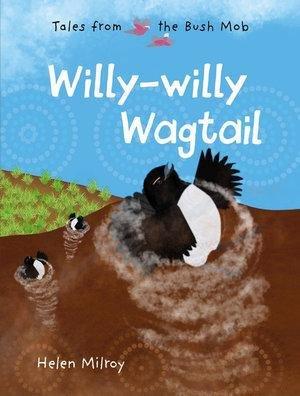This beautifully illustrated book, comprised of three linked short stories, is multi-layered. On one level it can be read as a story about the way in which the curious and friendly Willy Wagtail, through learning the different languages of the animals living in surrounding bushland, encourages the ‘bush mob’ to work together to save the community when devastating bushfires hit. On another level, this story illuminates the importance of learning about and preserving Indigenous language and culture (and indeed, reminds us all of the importance of learning more about the diverse range of cultures within our own communities).
Willy Wagtail is the only animal in the outback who makes the effort to learn the different languages of the various birds and animals living in surrounding bushland - even endeavouring to learn the language of the wind and the earth. Some of these languages are so old ‘they had been present since the beginning of time.’ Willy Wagtail sees that everyone has an important story to tell – even grumpy old Crow.
Willy Wagtail befriends old Crow, learning his language and listening to his stories. We observe the symbiotic nature of the relationship between old Crow and Willy Wagtail. Willy Wagtail brings Crow worms to eat and Crow grows strong and healthy. In return, Crow rescues Willy Wagtail when his wings get singed by fire.
Powerful themes emerge from the tales in this book, such as working together to find solutions, being kind to each other, and drawing strength from the sharing of knowledge (from one generation to another). The stories work together to highlight the importance of community. It is only through undertaking to understand each other that we can all move forward together in unity.
The stories have a dreamlike quality to them through the ebbing flow and rhythm of the text – reminiscent of Aboriginal Australian stories passed down from one generation to another.
The use of bright glossy colours in the illustrations will be sure to enchant readers of all ages. Helen Milroy has used traditional Aboriginal art techniques to create contemporary illustrations. We lose ourselves in the earthy greens and browns of the landscape, the vivid blue of the skies, and the swirling streaks of yellow, orange and red when the bushfires hit.
The wind, earth and fire are personalised and given character – encouraging us to be aware of listening to nature, living in harmony with it, and protecting our resources.
Reading this book may lead to classroom discussion about the significance of the willy wagtail in Aboriginal culture, Aboriginal art techniques, the role of elders in Aboriginal culture, and the importance of preserving Indigenous language.
Helen Milroy is a descendant of the Palyku people of the Pilbara region of Western Australia.
Series: Tales from the Bush Mob no 1

